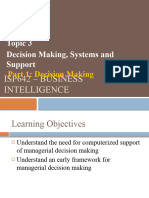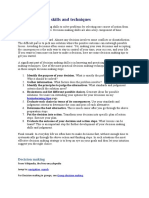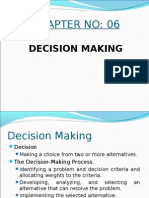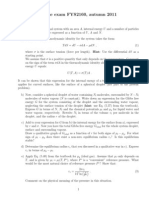Decision Making and Problem Solving Notes
Uploaded by
foundationbrucewayneDecision Making and Problem Solving Notes
Uploaded by
foundationbrucewayneDecision Making and Problem Solving Notes (CSiR Batch by Vyasa IAS) - Sample
What is Decision Making?
Decision-making is an integral part of modern management. Essentially, Rational or sound decision making is taken as
primary function of management. Every manager takes hundreds and hundreds of decisions subconsciously or
consciously making it as the key component in the role of a manager. Decisions play important roles as they determine
both organizational and managerial activities.
• A decision can be defined as a course of action purposely chosen from a set of alternatives to achieve
organizational or managerial objectives or goals. Decision making process is continuous and indispensable
component of managing any organization or business activities.
• Decisions are made to sustain the activities of all business activities and organizational functioning. Decision
making process is a consultative affair done by a comity of professionals to drive better functioning of any
organization.
• Decision making process can be regarded as check and balance system that keeps the organisation growing
both in vertical and linear directions. It means that decision making process seeks a goal.
Definition of Decision Making
• According to the Oxford Advanced Learner’s Dictionary, the term decision making means - the process of
deciding about something important, especially in a group of people or in an organization.
• Trewatha & Newport defines decision making process as follows, “Decision-making involves the selection of a
course of action from among two or more possible alternatives in order to arrive at a solution for a given
problem”.
Important Steps to Decision Making
1) Evaluation of alternatives: As a first step, you can start Decision Making by identifying and generating possible
alternatives to address a given situation or problem.
2) Rationality and objectivity: To make a correct rational Decision involves a systematic analysis of available
information, weighing the pros and cons of each alternative, and choosing the most logical and beneficial option.
3) Heuristics and biases: In some cases, you may have mental shortcuts to make decisions quickly. However, remember
that these shortcuts can also introduce biases and lead to suboptimal choices.
4) Decision making under uncertainty: Often, decisions must be made with incomplete or uncertain information. This
requires you to make risk assessments. You also need to have the ability to adapt to changing circumstances.
5) Group Decision Making: In collaborative environments, decisions may be made collectively through group
discussions, brainstorming, and consensus-building. This approach leverages diverse perspectives and expertise.
6) Strategic Decision Making: In organisations, you need to make strategic Decision Making. It involves considering long-
term implications, aligning decisions with organisational goals, and anticipating potential impacts on stakeholders.
7) Ethical considerations: Ethical Decision Making involves assessing the moral implications of choices. It revolves
around making decisions that align with your values and principles.
CALL/WHATSAPP 8851628134 FOR MORE INFORMATION 1
Decision Making and Problem Solving Notes (CSiR Batch by Vyasa IAS) - Sample
8) Learning from outcomes: To be an effective decision-maker, you need to learn from both successful and unsuccessful
outcomes to improve your future Decision Making processes.
Understanding Problem Solving
• Problem Solving is a critical cognitive process that allows individuals to address obstacles, overcome difficulties,
and achieve desired outcomes.
• It involves a systematic approach to understanding the issue, identifying possible solutions, and implementing
the most effective resolution. This helps you to navigate complexities and arrive at successful conclusions.
Some tips that can help you in Problem Solving effectively:
1) Problem identification: As a first step towards Problem Solving, effectively carry out tasks. Also, recognise and define
the issue or challenge that needs to be addressed.
2) Data gathering: Gathering relevant information and data related to the problem is essential for understanding its root
causes and implications. This helps you become a good problem solver.
3) Analysis and diagnosis: Analyse the gathered information to identify the underlying causes of the problem. This helps
you in devising targeted solutions.
4) Solution generation: Brainstorming and generating multiple potential solutions is crucial for you when you are
exploring diverse approaches to resolve the problem.
5) Evaluation of alternatives: Carefully evaluate the pros and cons of each solution. This helps you in selecting the most
feasible and effective one.
6) Implementation: After choosing a solution, you have to put the chosen solution into action. This requires planning,
coordination, and effective execution.
7) Creative thinking: Employing creative thinking approaches can lead you to have innovative solutions to complex
problems.
8) Root Cause Analysis: Identifying and addressing the root cause of a problem ensures that you have a more
sustainable and lasting solution.
Difference between decision making and problem solving
Aspect Decision Making Problem Solving
Definition Selecting from available alternatives to Identifying and resolving an issue or challenge
achieve a specific goal or outcome. to reach a desired state.
Objective Making a choice among options. Finding a solution to a problem
Focus Choosing the best course of action. Understanding the problem and generating
potential solutions
Process Evaluating alternatives, considering risks and Identifying the problem, gathering data,
rewards. analysing, and implementing solutions.
Rationality Often involves a logical and systematic Requires critical thinking and creativity.
approach.
Input Involves available information and past Data and insights related to the problem at
experiences. hand.
CALL/WHATSAPP 8851628134 FOR MORE INFORMATION 2
Decision Making and Problem Solving Notes (CSiR Batch by Vyasa IAS) - Sample
Outcome Leads to a final decision. Results in a resolved problem or improved
situation.
Examples Often applied to challenges or obstacles in Troubleshooting technical issues and finding
various domains. solutions to production problems.
Interrelation Decision Making may follow effective Effective Problem Solving often leads to better
Problem Solving. Decision Making.
Context Applicable to a wide range of situations. Often applied to challenges or obstacles in
various domains.
How can you integrate Decision Making and Problem Solving?
You are aware of the differences between Problem Solving and Decision Making abilities. But you need to integrate
these two special skills so that you can carry out challenging tasks or situations, both in the workplace and in your
personal life. The following tips will help you show how you can take effective decisions and simultaneously solve
problems:
1) Foster a systematic approach: You can start by adopting a systematic approach to Problem Solving. It involves
defining the issue, gathering relevant information, analysing data, generating potential solutions, and evaluating
alternatives. Then, you can implement your structured Problem Solving process, which provides a solid foundation for
your informed Decision Making.
2) Identify decision points: You can recognise the key decision points within the Problem Solving Process. You have to
then determine which factors require choices. Then weigh the consequences of each decision on the overall problem-
solving outcome.
3) Incorporate critical thinking: You can emphasise your critical thinking throughout both Problem Solving and Decision
Making. Engage in objective analysis so that you can consider multiple perspectives and challenge assumptions to arrive
at well-rounded solutions and decisions.
4) Utilise data-driven decisions: Ensure that the decisions made during the Problem Solving process are backed by
relevant data and evidence. Your data-driven Decision Making minimises biases and increases the chances of arriving at
the most suitable solutions.
How to use Problem Solving and Decision Making skills
To improve your efficiency at work, you can follow a streamlined and organized approach to solve problems and make
decisions. Here are five steps that you can follow to make the most of your problem-solving and decision-making skills:
1. Define the issue
The first step is to define the problem or issue. Once you've pinpointed the issue, analyze it and think about what might
have caused it. Try to identify any smaller issues within the main problem. It's important to understand the issue before
you start thinking about potential solutions and decisions. Having a clearly defined problem can make it easier to make
decisions later on in the process. Define or state your issue in as specific terms as possible so it's easy to understand. To
determine the needs of the issue, you might ask yourself:
• What factors are contributing to this issue?
• Who are the people involved with the issue?
• When is this issue occurring?
CALL/WHATSAPP 8851628134 FOR MORE INFORMATION 3
Decision Making and Problem Solving Notes (CSiR Batch by Vyasa IAS) - Sample
• Where is this issue taking place?
These questions can clarify information related to the issue to help you and others understand the issue as much as
possible before moving forward with creating a solution.
2. Brainstorm different approaches
After you've defined and analyzed the issue, you can begin brainstorming different approaches to resolving it. In an
effort to see all sides of the problem, try to get feedback from mentors and people involved with the issue. You can also
think about how you've solved past problems similar to the current issue. Be sure to consider both short- and long-term
approaches to the issue.
You can brainstorm independently or collaboratively, and you can use tools like a whiteboard or online software to
illustrate your brainstorming. Common brainstorming techniques include:
• Mind mapping: Mind mapping is creating illustrations of ideas in hierarchical layouts. Mind maps can show the
relationships between different aspects of an issue, making this technique fitting for problem-solving and
decision-making.
• SWOT Analysis: You can use SWOT (Strength, Weakness, Opportunities, Threat) analysis to identify the
strengths, weaknesses, opportunities and threats related to an issue. Understanding these important
components can help you to come up with potential solutions.
• Flowcharts: Flowcharts can be useful for illustrating processes and workflows, so they can be helpful in planning
a process to respond to an issue. Creating a flowchart can help you organize your ideas and design step-by-step
solutions to problems.
• Rapid ideation: Rapid ideation is a brainstorming technique in which everyone involved with an issue writes as
many potential solutions as they can think of in a short amount of time. After everyone writes their ideas, you
can review them as a team.
3. Evaluate different approaches
After you've brainstormed approaches, it's time to evaluate them. Think through all the pros and cons for each option,
and consider how each one would affect your organization. Think about the different resources that each decision would
require. Taking all these factors into consideration can help you make the best decision for your company.
4. Make your decision
Once you have evaluated your different approaches, it's time to make your decision. You can choose from different
decision-making structures, which include:
• Collaborative decision making: This decision-making structure includes input from a variety of opinions.
• Command decision making: In this structure, you make a decision without getting feedback from other people,
which can be the fastest way to decide.
• Vote decision making: This decision-making structure lets you get input from numerous people in a short
amount of time. It allows people to vote on a decision from a set of options.
• Consensus based decision making: In this structure, everyone involved attempts to agree on a decision. This
process can be lengthy, so it's ideal if a decision is not time-sensitive and if you want to make sure your decision
has complete support.
CALL/WHATSAPP 8851628134 FOR MORE INFORMATION 4
Decision Making and Problem Solving Notes (CSiR Batch by Vyasa IAS) - Sample
After making your decision, ensure it fully addresses the issue and does not create a new one. Make sure the decision is
something that your company can realistically implement and it aligns with the mission, vision and values of the
company.
5. Implement your decision
After you've made your decision, you can decide how to implement it. Start by identifying primary objectives and
deliverables and creating deadlines. Then, outline specific steps to meet the objectives. In the implementation plan, you
can include those who are involved with the issue and assign responsibilities to the employees. Then, share your plan
with everyone involved with the issue and get feedback.
CALL/WHATSAPP 8851628134 FOR MORE INFORMATION 5
Decision Making and Problem Solving Notes (CSiR Batch by Vyasa IAS) - Sample
CALL/WHATSAPP 8851628134 FOR MORE INFORMATION 6
You might also like
- Decision Making, Systems and Support - Part 1No ratings yetDecision Making, Systems and Support - Part 143 pages
- Week 3 - EnGG 406 - Decision Making - CorrectedNo ratings yetWeek 3 - EnGG 406 - Decision Making - Corrected47 pages
- Decision Making and Problem Solving - Critical CareNo ratings yetDecision Making and Problem Solving - Critical Care7 pages
- Content for Modules 6-10 in Leadership and Management TrainingNo ratings yetContent for Modules 6-10 in Leadership and Management Training55 pages
- Narrative Report Decision Making ProcessNo ratings yetNarrative Report Decision Making Process4 pages
- Apply critical thinking to work practices presentationNo ratings yetApply critical thinking to work practices presentation60 pages
- Decision Making Decision Making Process DefinedNo ratings yetDecision Making Decision Making Process Defined8 pages
- 01 Introduction To Quantitative AnalysisNo ratings yet01 Introduction To Quantitative Analysis58 pages
- L2 - Decision Making, Systems, Modeling and SupportNo ratings yetL2 - Decision Making, Systems, Modeling and Support52 pages
- Smart Decisions: Mastering Problem Solving with Strategic Solutions for Business SuccessFrom EverandSmart Decisions: Mastering Problem Solving with Strategic Solutions for Business SuccessNo ratings yet
- Complete Download Stuttering An Integrated Approach to its Nature and Treatment 5th Edition Guitar PDF All Chapters100% (1)Complete Download Stuttering An Integrated Approach to its Nature and Treatment 5th Edition Guitar PDF All Chapters52 pages
- Medical Consultant Interview Question by ISC Medical Leaders in Medical IntervNo ratings yetMedical Consultant Interview Question by ISC Medical Leaders in Medical Interv33 pages
- Full download Hearing the Crimean War: Wartime Sound and the Unmaking of Sense 1st Edition Gavin Williams pdf docx100% (3)Full download Hearing the Crimean War: Wartime Sound and the Unmaking of Sense 1st Edition Gavin Williams pdf docx41 pages
- Summary of the interview with Australian biologist Jeremy GriffithNo ratings yetSummary of the interview with Australian biologist Jeremy Griffith9 pages
- Consumer Analytics Course Outline - 2024No ratings yetConsumer Analytics Course Outline - 20247 pages
- Student Industrial Attachment Report by Muthama David .M. S11/21490/14No ratings yetStudent Industrial Attachment Report by Muthama David .M. S11/21490/147 pages
- Alba - Mary Jeanina - Reflection Paper #2No ratings yetAlba - Mary Jeanina - Reflection Paper #22 pages
- Science 2 Detailed Lesson Plan For Educ 114No ratings yetScience 2 Detailed Lesson Plan For Educ 1149 pages
- Dog Breed Identification: Whitney Larow Brian Mittl Vijay SinghNo ratings yetDog Breed Identification: Whitney Larow Brian Mittl Vijay Singh7 pages
- LAB 03a-Manage Azure Resources by Using The Azure PortalNo ratings yetLAB 03a-Manage Azure Resources by Using The Azure Portal3 pages
- Home Exam in FYS2160 - Thermodynamics and Statistical PhysicsNo ratings yetHome Exam in FYS2160 - Thermodynamics and Statistical Physics3 pages
- Geospatial - Technology Competency Model 2023No ratings yetGeospatial - Technology Competency Model 202331 pages
- Decision Making and Problem Solving - Critical CareDecision Making and Problem Solving - Critical Care
- Content for Modules 6-10 in Leadership and Management TrainingContent for Modules 6-10 in Leadership and Management Training
- Apply critical thinking to work practices presentationApply critical thinking to work practices presentation
- L2 - Decision Making, Systems, Modeling and SupportL2 - Decision Making, Systems, Modeling and Support
- Smart Decisions: Mastering Problem Solving with Strategic Solutions for Business SuccessFrom EverandSmart Decisions: Mastering Problem Solving with Strategic Solutions for Business Success
- Decide Well: Tools for Effective Decision MakingFrom EverandDecide Well: Tools for Effective Decision Making
- Complete Download Stuttering An Integrated Approach to its Nature and Treatment 5th Edition Guitar PDF All ChaptersComplete Download Stuttering An Integrated Approach to its Nature and Treatment 5th Edition Guitar PDF All Chapters
- Medical Consultant Interview Question by ISC Medical Leaders in Medical IntervMedical Consultant Interview Question by ISC Medical Leaders in Medical Interv
- Full download Hearing the Crimean War: Wartime Sound and the Unmaking of Sense 1st Edition Gavin Williams pdf docxFull download Hearing the Crimean War: Wartime Sound and the Unmaking of Sense 1st Edition Gavin Williams pdf docx
- Summary of the interview with Australian biologist Jeremy GriffithSummary of the interview with Australian biologist Jeremy Griffith
- Student Industrial Attachment Report by Muthama David .M. S11/21490/14Student Industrial Attachment Report by Muthama David .M. S11/21490/14
- Dog Breed Identification: Whitney Larow Brian Mittl Vijay SinghDog Breed Identification: Whitney Larow Brian Mittl Vijay Singh
- LAB 03a-Manage Azure Resources by Using The Azure PortalLAB 03a-Manage Azure Resources by Using The Azure Portal
- Home Exam in FYS2160 - Thermodynamics and Statistical PhysicsHome Exam in FYS2160 - Thermodynamics and Statistical Physics

























































































